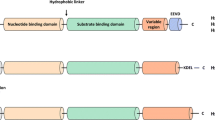Abstract
Heat shock proteins (HSPs) are key stress proteins induced in cells exposed to proteotoxic insult and are critical for thermotolerance. The dynamic network of chaperone interactions, known as the chaperome, contributes significantly to the proteotoxic cell response and the malignant phenotype in cancer. We identified a potent microRNA, miR-570 that could bind the 3′untranslated regions of multiple HSP mRNAs and inhibit HSP synthesis. Here, we will introduce the transfection and thermotolerance methods for analysis of miR-570 targeting the HSP chaperone network.
Access this chapter
Tax calculation will be finalised at checkout
Purchases are for personal use only
Similar content being viewed by others
References
Lang BJ et al (2021) The functions and regulation of heat shock proteins; key orchestrators of proteostasis and the heat shock response. Arch Toxicol. https://doi.org/10.1007/s00204-021-03070-8
Ellis RJ (2007) Protein misassembly: macromolecular crowding and molecular chaperones. Adv Exp Med Biol 594:1–13. https://doi.org/10.1007/978-0-387-39975-1_1
Hartl FU (1996) Molecular chaperones in cellular protein folding. Nature 381:571–579. https://doi.org/10.1038/381571a0
Ciocca DR, Calderwood SK (2005) Heat shock proteins in cancer: diagnostic, prognostic, predictive, and treatment implications. Cell Stress Chaperones 10:86–103. https://doi.org/10.1379/csc-99r.1
Bartel DP (2009) MicroRNAs: target recognition and regulatory functions. Cell 136:215–233. https://doi.org/10.1016/j.cell.2009.01.002
Bartel DP (2018) Metazoan MicroRNAs. Cell 173:20–51. https://doi.org/10.1016/j.cell.2018.03.006
Fabian MR, Sonenberg N, Filipowicz W (2010) Regulation of mRNA translation and stability by microRNAs. Annu Rev Biochem 79:351–379. https://doi.org/10.1146/annurev-biochem-060308-103103
Baker JR et al (2019) MicroRNA-570 is a novel regulator of cellular senescence and inflammaging. FASEB J 33:1605–1616. https://doi.org/10.1096/fj.201800965R
Okusha Y et al (2022) MicroRNA-570 targets the HSP chaperone network, increases proteotoxic stress and inhibits mammary tumor cell migration. Sci Rep 12:15582. https://doi.org/10.1038/s41598-022-19533-6
Acknowledgements
We wish to thank the Department of Radiation Oncology for their continued support. This work was supported by the National Institutes of Health grant R01CA176326 (SKC).
Author information
Authors and Affiliations
Corresponding author
Editor information
Editors and Affiliations
Rights and permissions
Copyright information
© 2023 The Author(s), under exclusive license to Springer Science+Business Media, LLC, part of Springer Nature
About this protocol
Cite this protocol
Okusha, Y., Calderwood, S.K. (2023). Transfection and Thermotolerance Methods for Analysis of miR-570 Targeting the HSP Chaperone Network. In: Calderwood, S.K., Prince, T.L. (eds) Chaperones. Methods in Molecular Biology, vol 2693. Humana, New York, NY. https://doi.org/10.1007/978-1-0716-3342-7_6
Download citation
DOI: https://doi.org/10.1007/978-1-0716-3342-7_6
Published:
Publisher Name: Humana, New York, NY
Print ISBN: 978-1-0716-3341-0
Online ISBN: 978-1-0716-3342-7
eBook Packages: Springer Protocols




